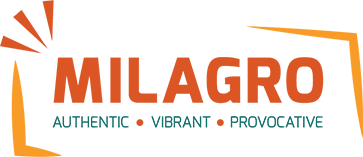2023 Cycle Artists and Projects
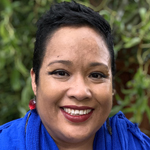 Anabertha Martinez is originally from Guanajuato, Mexico. She immigrated to the United States in 1994. Beginning a broad career in the area of Health Promoters, with the Oregon State University Extension program. Specializing in nutrition education and program implementation for the Latino community in NE Portland. Anabertha Martinez is originally from Guanajuato, Mexico. She immigrated to the United States in 1994. Beginning a broad career in the area of Health Promoters, with the Oregon State University Extension program. Specializing in nutrition education and program implementation for the Latino community in NE Portland.READ MORE In 2003, she integrated into early childhood parenting education programs. Applying his knowledge to the ongoing development of parent leadership in the Portland Public Schools and surrounding areas. Faithful believer of Popular Education. Specialist in the development and training of health promoters in different areas: Education, civic leadership, advocacy and navigation of access systems to community resources. She has been a volunteer for over 28 years in various fields of leadership, civic engagement, early education, and health. Passionate about personal development and law. In her free time she likes to travel, read, spend time with her 4 children and her little grandson. When inspiration strikes, he writes poems. Discovering herself as: Poet, Media Loca and Lover of life.
We are Caminos de Crecimiento (Journeys of Growth), a self-directed community group dedicated to reading and writing books to increase personal awareness and creative expression for community engagement and transformation. We are 14 members who have written a Spanish language book called Historias de crecimiento (Stories of Growth), featuring personal stories, original poetry, photos, and paintings. Our goal is for our community to see and hear our stories in our own words. We want our community to learn from our experiences and bond over shared experiences, and grow together. Our project aims to facilitate a series of engaging Spanish language community workshops, designed to foster a deep connection among participants through shared experiences and discussions. These workshops will focus on promoting cultural enrichment, self-expression, and personal growth by delving into a variety of themes that resonate with people from all walks of life. With a carefully planned agenda, we aspire to create a nurturing and supportive environment that enables participants to open up, share, and learn from each other. To ensure a comprehensive experience, the workshops will be structured around three main activities: a collective book reading (Historias de crecimiento), in-depth conversations, and a concluding abstract painting session. Our book, rich in thematic content, will serve as a catalyst for thought-provoking discussions and help us explore themes such as family, marriage, formative childhood experiences, coming of age, overcoming abuse, self-empowerment, and the search for love. We believe that addressing these topics in a safe and inclusive setting will encourage participants to reflect on their own lives and foster a deeper understanding of themselves and others. The first segment of the workshop will involve reading the book Historias de crecimiento together. This shared experience will not only allow participants to absorb the story and its themes but also promote a sense of unity and camaraderie among the group. Following the reading, we will transition into guided conversations, wherein participants will have the opportunity to express their thoughts, feelings, and perspectives on the various themes presented in the book. Through these discussions, we hope to facilitate meaningful connections and foster a sense of empathy and mutual support among participants. In the final segment of the workshop, participants will be encouraged to channel their emotions and newfound insights into abstract painting. This creative outlet will serve as a means of self-expression and self-discovery, allowing participants to explore their thoughts and feelings in a more tangible and visual form. The process of creating abstract art will also provide a therapeutic experience, helping individuals to process and make sense of their emotions in a constructive and fulfilling way. Our goal is to conduct a single two hour workshop, catering to a cohort of 25 participants. This intimate group size will enable us to maintain a close-knit and supportive atmosphere, ensuring that each individual feels heard and valued. In order to maximize the benefits of the workshop, we will provide each participant with two books, a journal, and a pen. These resources will not only facilitate active engagement during the workshop but also encourage personal reflection and growth beyond the confines of the session. In conclusion, we are confident that our Spanish language community engagement workshops will offer a unique and transformative experience for all participants. By combining elements of literature, discussion, and artistic expression, we aim to create a holistic approach to personal development and community building. Through the exploration of universal themes and shared experiences, we believe that our workshops will foster a deeper sense of understanding, empathy, and connection among participants, ultimately enriching their lives and contributing to the overall well-being of the community. Our Spanish language community engagement workshops are designed to serve and benefit the community in various ways. The workshops promote cultural enrichment by engaging participants with a Spanish-language book that encompasses themes that resonate with diverse audiences. They also foster personal development by addressing themes such as family, marriage, self-empowerment, and the search for love, encouraging reflection and self-awareness. The concluding abstract painting session provides participants with a therapeutic outlet for self-expression, promoting emotional well-being. The intimate group size of 25 participants allows for meaningful interactions and the formation of lasting connections, strengthening the bonds that unite community members. The workshops are designed to be accessible and welcoming to individuals from diverse backgrounds and with varying levels of experience in the arts, empowering participants to express their thoughts and emotions freely. By bringing together individuals who share common interests and experiences, the workshops contribute to the development of a cohesive, supportive community. The provision of two books, a journal, and a pen encourages participants to continue their personal exploration beyond the workshop, fostering intellectual curiosity and the desire for self-improvement. In summary, our Spanish language community engagement workshops promote cultural enrichment, personal development, emotional well-being, social connection, empowerment, inclusivity, community building, and lifelong learning, benefiting both individual participants and the community at large. |
 Peruvian Pride PDX is a small team of culture bearers. We want to share our dances and music with the Pacific Northwest. Oftentimes, Latin American countries are seen as homogeneous, for example erasing Afro-descendant latinos; and we would like to take this opportunity to highlight all the diversity within Peruvian culture, and other countries as well. An important ethos of ours is inclusivity. Peruvian Pride PDX is a small team of culture bearers. We want to share our dances and music with the Pacific Northwest. Oftentimes, Latin American countries are seen as homogeneous, for example erasing Afro-descendant latinos; and we would like to take this opportunity to highlight all the diversity within Peruvian culture, and other countries as well. An important ethos of ours is inclusivity.READ MORE We unfortunately still see a lot of discrimination or limitations for including performers of all genders, sexual orientations, physical and mental disabilities, financial resources, etc when it comes to traditional and folkloric shows, and we want to open our efforts to those who are historically marginalized. Peruvian Pride PDX welcomes all. Our team also does volunteering work in Portland Oregon, and we take pride in our ethics and community outreach.
With funding will perform at the South American Fest in September |
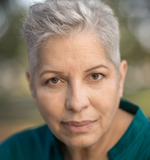 Bunnie Rivera has been in the entertainment business since 1989, beginning with Miracle Theater. She moved to Hollywood in 1995 to try her hand in the movie and TV business and has been in many television shows and films. The COVID lockdown gave her the opportunity to switch gears and develop her long latent storytelling roots and also, to change her brand from a passive observer playing maids and nurses, to a real creator in the business. THIS LAND IS, is her first production to become a reality and has a real opportunity to win awards. Bunnie has two more projects in development, IS THERE LIFE ON EUROPA and SUPER BOOMERS. Bunnie Rivera has been in the entertainment business since 1989, beginning with Miracle Theater. She moved to Hollywood in 1995 to try her hand in the movie and TV business and has been in many television shows and films. The COVID lockdown gave her the opportunity to switch gears and develop her long latent storytelling roots and also, to change her brand from a passive observer playing maids and nurses, to a real creator in the business. THIS LAND IS, is her first production to become a reality and has a real opportunity to win awards. Bunnie has two more projects in development, IS THERE LIFE ON EUROPA and SUPER BOOMERS. |
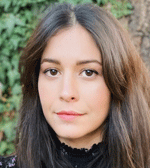 Clara Grun is a millennial Nicaraguan singer-songwriter with over 25 years of experience writing and performing lyrical pop, rock, and nueva trova music in Spanish and English. She started writing songs at age 13, inspired by the nueva canción movement, and recorded her first album “Pildorita del Caos” in 2005. She participated in the “Festival Internacional de Cantautoras” organized by world-renowned nueva canción singer-songwriter Katia Cardenal of Duo Guardabarranco and became one of the founders of the youth movement Rock Nica Ecológico, which sought to raise awareness about pressing ecological issues. Clara Grun is a millennial Nicaraguan singer-songwriter with over 25 years of experience writing and performing lyrical pop, rock, and nueva trova music in Spanish and English. She started writing songs at age 13, inspired by the nueva canción movement, and recorded her first album “Pildorita del Caos” in 2005. She participated in the “Festival Internacional de Cantautoras” organized by world-renowned nueva canción singer-songwriter Katia Cardenal of Duo Guardabarranco and became one of the founders of the youth movement Rock Nica Ecológico, which sought to raise awareness about pressing ecological issues.READ MORE In 2008 she recorded her second album, “El Arma Perfecta,” and in 2011 she collaborated with Nicaraguan singer-songwriters Gaby Baca and Elsa Basil on the song “Todas Juntas Todas Libres,” touring rural Nicaragua to promote solidarity in the struggle for women’s rights. She has received sponsorship from companies such as Pepsi and Spanish communications company Movistar for tours in Nicaragua, El Salvador, Guatemala, and Costa Rica and was the opening act for Grammy Award-winning Spanish musician Alejandro Sanz. She moved to Portland in 2015 and is currently the lead singer and keyboardist for A Cara o Cruz, a cumbia-rock band based in Gresham.
I am a singer-songwriter with four studio recordings from Nicaragua, where I had a successful career and was a prominent figure in the music scene. In 2015 I moved to Portland to start a family, and since then I have struggled to get my original work off the ground. In 2018 a student protest against the Sandinista government changed the political landscape in Nicaragua. I became a vocal opponent of the regime and wrote songs against it which were sung at protests in Managua. Consequently, returning home is no longer an option for me. However, I continue to perform and teach music here in Portland. Driven by the desire to create something unique, this grant would enable my first recording in over ten years and be the first step to becoming part of the Portland songwriter community. Performing with the cumbia-rock band A Cara o Cruz has allowed me to travel all over the Pacific Northwest and California. Native to a tropical country, I am constantly in awe of the beautiful scenery of evergreen trees. One afternoon in Mount Tabor, I sat under a Douglas fir with a guitar and started imagining trees acting like people with similar problems. Perhaps a tree could tell my story and in return, the tree would teach me its wisdom. That is how the idea of “A Song for Trees” was born. I invited my friend Amy Vanacore to join me in the songwriting because I knew she had a similar spiritual connection with trees. With Amy, songwriting evolved into an anthropomorphic practice in which the tree is the main character and inspiration. The artistic process consists of relating, back and forth, tree characteristics (e.g. roots, growth, protection) with human feelings (e.g. loneliness, grief, love). The lyrics are personal and describe situations that on a metaphorical level can be shared in common with trees, such as reaching toward the sky as an act of hope; rooting oneself as an individual in a community to experience a sense of belonging; branching out to express new ideas and occupy space. Our music is fueled by the tension between organic (acoustic) and synthetic (electronic) instruments. The genre is indie-folk with piano-driven arrangements and layered vocals. We want to record an EP at Falcon Recording Studio. They have recorded music for clients such as Pink Martini and Guitarist Terry Robb and come highly recommended by our colleagues. We are in the process of finding other local musicians for drums, bass, and guitar to complete our ensemble for the recording. Our social media manager will upload content to create anticipation for the digital release of the EP. Once the album is completed, it will be available for download for $10 on Bandcamp. Each of our respective communities will be invited to follow us and download the EP. We will also promote the EP on FB and IG, and publicize our upcoming shows on our website and via local media. I currently have 10,000 FB followers and 3,700 IG followers and Amy has an extensive network of students and colleagues that will be invited to follow us on social media. Our diverse audience will include children, adults, Latinx community, immigrants, and LGBTQIA+ folx, building on my and Amy’s existing relationships in the Portland metro area. We will begin performing together in October 2023 and expect A Song for Trees to have over 1,000 followers by the end of 2023. We plan to perform in Portland as well as in Gresham and Hillsboro, and we will place a sign with a QR code at concerts so the EP can be downloaded on the spot. We hope to play our own shows and perform as an opening act for local Latinx, queer, indie, and women-led bands. As a Latina immigrant, the cultural shock of adjusting to life in the US has strengthened my connection to my own “Latinidad.” By consistently playing music that reminds me of home, I now feel like I finally belong here. This new sense of belonging and of feeling at home surrounded by evergreens has given me the confidence to finally present my original work to this community. The music for A Song for Trees speaks about my experience and struggles with love, nostalgia, and grief. I want to express myself and become known as a songwriter here in Portland. I felt that the songs could benefit from another woman musician’s perspective so that is why I invited Amy who also comes from a marginalized community (LGBTQ) and who also has strong ties within our Latinx communities as an activist and pianist. Support from this fund will contribute to our unique creative collaboration and the vitality of the ethnically and socioeconomically diverse communities in which we live. As two women of different backgrounds and ages, we are, through our musical collaboration, creating an intergenerational, international, inter-ethnic, inter-lingual, queer-friendly, family-friendly community that goes beyond inclusivity and strives to foster a deep sense of belonging for ourselves, for each other, and for our communities. In an effort to make our performances as inclusive as possible, we will perform only at ADA-accessible venues, we will prioritize venues with all-gender restrooms, we will actively seek out opportunities to open for bands at ASL-interpreted concerts, and we will offer self-identified low-income students and families free or sliding-scale tickets to performances. We will also promote our concerts and EP in both English and Spanish via our website, FB, IG, and local media. Our shared vision is to create a safe space where people of all backgrounds can feel welcome, supported, and celebrated and connect to their feelings and each other through our music. |
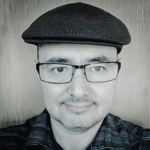 Diego Gioseffi (Joseph-e) was born and raised in Buenos Aires. Mix race from arab, quechua, calabrese, arbëreshë, and french-welsh ancestors. While visual arts and music was central to the family, Diego studied mechanics in high school and economics at the University of Buenos Aires. He worked since he was 16 years old as a photo lab technician and assistant photographer, taking stills for movies and social photos on political events, and never has put the camera down since. Diego Gioseffi (Joseph-e) was born and raised in Buenos Aires. Mix race from arab, quechua, calabrese, arbëreshë, and french-welsh ancestors. While visual arts and music was central to the family, Diego studied mechanics in high school and economics at the University of Buenos Aires. He worked since he was 16 years old as a photo lab technician and assistant photographer, taking stills for movies and social photos on political events, and never has put the camera down since.READ MORE He left a “promising” career in the financial world to find meaningful work in oceans, producing underwater videos and spearheading environmental education programs. This work and his curiosity took him to Mexico, Dominican Republic, Thailand, Hawaii and Tanzania, where in addition to environmental education that tied to his photography and video art, he coordinated innovative coral and mangrove restoration and monitoring projects. He moved “temporarily” to Portland 15 years ago, and continue to struggle with the sense of belonging. He is a photographer, videographer, piano player, and he has been drawn on the last ten years to painting and mi media collages. Most of his work comes from the realm of dreams, healing practices and his numerous readings about arts, politics, history, economy, social justice and decolonized natural history.
The project aims to put together an art show with mix media collages that provoke thoughts and feelings about nature, colonization, racism and the environmental movement. The name sanshui derives from the ancient chinese form of landscapes with poetry. I am to produce these mix media collages with a poem embedded on them. It is kind of a joke on cultural appropiation and also nod to this form of multi layered ancient art. Diego has been working on these ideas for over two decades, has already some sketches and finalized works. The idea includes collaboration with black and brown people in the art and environmental movement: There will be some printed reflections on nature from these oregon BIPOC environmental leaders on the show. How black, brown and indigenous people perceptions of ourselves in nature and how nature has been racialized by the dominant white culture? I hope to just to share images that will spark thoughts, tension and wonder. The art is plan to be exhibited at the Salmon Homecoming Festival at Oxbow Regional Park on October 2024. (Joseph-e) was born and raised in Buenos Aires. Mix race from arab, quechua, calabrese, arbëreshë, and french-welsh ancestors. While visual arts and music was central to the family, Diego studied mechanics in high school and economics at the University of Buenos Aires. He worked since he was 16 years old as a photo lab technician and assistant photographer, taking stills for movies and social photos on political events, and never has put the camera down since. His photo works are both on digital and medium format film. As Diego awoke one morning from uneasy dreams he found himself transformed in his bed into a gigantic insect. He left a “promising” career in the financial world to find meaningful work in oceans, producing underwater videos and spearheading environmental education programs. This work and his curiosity took him to Mexico, Dominican Republic, Thailand, Hawaii and Tanzania, where in addition to environmental education that tied to his photography and video art, he coordinated innovative coral and mangrove restoration and monitoring projects. He moved “temporarily” to Portland 15 years ago, and continue to struggle with the sense of belonging. He is a photographer, videographer, piano player, and he has been drawn on the last ten years to painting and mi media collages. Most of his work comes from the realm of dreams, healing practices and his numerous readings about arts, politics, history, economy, social justice and decolonized natural history. The project aims to put together an art show with mix media collages that provoke thoughts and feelings about nature, colonization, racism and the environmental movement. The name sanshui derives from the ancient chinese form of landscapes with poetry. I am to produce these mix media collages with a poem embedded on them. It is kind of a joke on cultural appropiation and also nod to this form of multi layered ancient art. Diego has been working on these ideas for over two decades, has already some sketches and finalized works. The idea includes collaboration with black and brown people in the art and environmental movement: There will be some printed reflections on nature from these oregon BIPOC environmental leaders on the show. How black, brown and indigenous people perceptions of ourselves in nature and how nature has been racialized by the dominant white culture? I hope to just to share images that will spark thoughts, tension and wonder. The art is plan to be exhibited at the Salmon Homecoming Festival at Oxbow Regional Park on October 2024. (Joseph-e) was born and raised in Buenos Aires. Mix race from arab, quechua, calabrese, arbëreshë, and french-welsh ancestors. While visual arts and music was central to the family, Diego studied mechanics in high school and economics at the University of Buenos Aires. He worked since he was 16 years old as a photo lab technician and assistant photographer, taking stills for movies and social photos on political events, and never has put the camera down since. His photo works are both on digital and medium format film. As Diego awoke one morning from uneasy dreams he found himself transformed in his bed into a gigantic insect. He left a “promising” career in the financial world to find meaningful work in oceans, producing underwater videos and spearheading environmental education programs. This work and his curiosity took him to Mexico, Dominican Republic, Thailand, Hawaii and Tanzania, where in addition to environmental education that tied to his photography and video art, he coordinated innovative coral and mangrove restoration and monitoring projects. He moved “temporarily” to Portland 15 years ago, and continue to struggle with the sense of belonging. He is a photographer, videographer, piano player, and he has been drawn on the last ten years to painting and mi media collages. Most of his work comes from the realm of dreams, healing practices and his numerous readings about arts, politics, history, economy, social justice and decolonized natural history. The project aims to put together an art show with mix media collages that provoke thoughts and feelings about nature, colonization, racism and the environmental movement. The name sanshui derives from the ancient chinese form of landscapes with poetry. I am to produce these mix media collages with a poem embedded on them. It is kind of a joke on cultural appropiation and also nod to this form of multi layered ancient art. Diego has been working on these ideas for over two decades, has already some sketches and finalized works. The idea includes collaboration with black and brown people in the art and environmental movement: There will be some printed reflections on nature from these oregon BIPOC environmental leaders on the show. How black, brown and indigenous people perceptions of ourselves in nature and how nature has been racialized by the dominant white culture? I hope to just to share images that will spark thoughts, tension and wonder. The art is plan to be exhibited at the Salmon Homecoming Festival at Oxbow Regional Park on October 2024. |
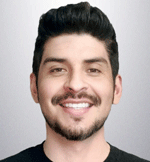 Eliborio Limon was born in Fresno California, from Mexican immigrant parents. My father is from Zacatecas, and my mother from Jalisco. My family’s work ethic helped me stay committed to Folklorico. I have been involved in the art of Folklorico Mexicano since the age of six. I began my teaching career in 2010, and I have over 25 years of dancing and instruction experience in Folklorico dance. It has not only provided me with dancing skills to express my culture art, but also helped me develop healthy social skills, insight with structuring an organization, and a Eliborio Limon was born in Fresno California, from Mexican immigrant parents. My father is from Zacatecas, and my mother from Jalisco. My family’s work ethic helped me stay committed to Folklorico. I have been involved in the art of Folklorico Mexicano since the age of six. I began my teaching career in 2010, and I have over 25 years of dancing and instruction experience in Folklorico dance. It has not only provided me with dancing skills to express my culture art, but also helped me develop healthy social skills, insight with structuring an organization, and aREAD MORE healthy discipline, that has evolved into leadership skills. This healthy development from Folklorico has motivated me to instill this healthy culture attributes from Folklorico into my students, in hopes of them being our future leaders. My first group that I joined was Ballet Folklorico y Marimba de Fresno. In 2010, I and two other directors formed, Mestizos Del Valle Dance Company, this is where my instruction and organizational building skills began. These two groups have been around for over 10 years and continue to provide culture awareness in the form Folklorico and develop healthy students for their communities.
|
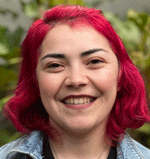 Eviana Vergara studied at California State Polytechnic University, Pomona earning her bachelors in Journalism while working on campus as a photo editor, orientation leader and intern for Snapchat shortly before graduating in 2018. Eviana Vergara studied at California State Polytechnic University, Pomona earning her bachelors in Journalism while working on campus as a photo editor, orientation leader and intern for Snapchat shortly before graduating in 2018.In conjunction with school, Eviana spent weekends working on any film set she could find as a production/camera assistant to start her journey into filmmaking. These opportunities fueled her passion for putting on her own READ MORE projects including hosting her first photo gallery with friends at the Pomona Art Walk in 2017, “Frameless” along with Jorge Ortega and Valerie Soriano.
After a year of interning at Snap, her role expanded to become an IT Technical Producer full-time and leading the Latinx Employee Resource Group, SnapFamilia, in 2020. Another shift brought by the pandemic led her to leave Snap and move to the Pacific Northwest where she continued to focus on her creative expressions. After settling in, she joined a Latinx Pop band, Caicedo, performing at local venues. In late 2022, she started development on her first short film, ORGULLO, where she raised $4,500. She is now in the post-production process and on her way to build her own creative agency, Step Zero Studios. |
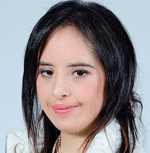 Gabriela Vidal Alvarado – LOVE – A Photo & Poetry Book Gabriela Vidal Alvarado – LOVE – A Photo & Poetry BookI´m a young woman with Down Syndrome that immigrated to the USA from Peru at 14 years old. I studied at High School Special Education in Maryland. After my graduation, I travelled to different Latin American countries following my mother´s work missions. Those trips gave me opportunities, but losses too. To build up my art skills I got training in television and radio for people with disabilities, painting, photography. READ MORE Lately, memoir writing, poetry, video, and song writing at “PHAME” in Portland, Oregon. Achieving my autonomy has driven my personal and artistic development; however, 13 years ago I started experiencing symptoms of Down Syndrome Regressive Disorder limiting my speech and motor skills. Poetry and photography became mediums to express deeper feelings that otherwise are difficult for me to convey. I have a great team supporting my development, my mother, sister, and brother-in-law; and my teachers at PHAME. This application is possible because my team at home helped me writing it, based on months of conversations, previous projects, and planning on what I feel, enjoy, and want to create for a new art project. They support me in project day-to-day tasks and progression so I can focus on my poetry and photography.
Photography and writing have become my two main mediums of expression, I paint too but I have focused on the previous ones in the last two years. Last year, my teachers at PHAME and my family motivated me to share my art, I decided to create the Calendar 2023 ¨Awesome Nature¨ illustrated with my photographs and poems. I sold all of them and I received very good feedback. I realized that sharing my art motivates me and makes me feel proud of myself. This year my project is to create an illustrated collection of my poetry. My poetry approach utilizes a strong element of self-reflection and is accessible to everyone. The themes that naturally appears in my art include nature and family, grieving losses, being a woman, and hopes for the future. My family says that women´s art can contribute to reduce the gender gap in the creative and cultural arenas. More women participating in arts is essential to address the unequal representation of women in positions of power and influence. Through my art and my voice, I want to send a message to all about more inclusion, and equal rights. My project is to create an illustrated collection of written poetry about my journey as a young woman with Down Syndrome. Poetry is important for me to express my emotions, views, experiences, and to highlight my capacities. This first book will also convey my voice for gender equality and inclusion. The outcome of this project is four pronged: i) a self-published bound book of 25-30 pages of my poetry, written in Spanish and translated into English, illustrated with my photographs; 200 units will be printed; ii) comms and social media promotion for reading events and marketing the book; and iv) creation of my personal branding to develop a network of bilingual (Spanish/English) Down Syndrome women creators (poets, photographers) for contact, and interaction. The last two ones are the main goals expected to achieve with the support of Milagro Latino Artist Fund. The project involves the support from a literary coach, a graphic designer, a printing shop, and a communicator and social media coach. Outlined below are the specific support they will and the qualifications that led to their selection. • Literary coach: her support focuses on exploring different poems, the structures, meter, and rhyming schemes. This support will also be in the editing and translating of the poems from Spanish into English. This coach was selected because of her experience, I have worked with her in the past, and she understands my intentions and style of poetry. • Graphic designer/Illustrator: who will support with the digitalization of the book, format, and layout for printing. This designer was selected because he has technical skills, and experience working with clients with Autism and Down Syndrome for art projects. • Communicator (Comms) and social media coach to create my personal branding, the comms and social media strategy for marketing and networking. This person will have experience in branding with emphasis in arts, gender, and disability. The audience for the book is any person or community that enjoys poetry and photography, is interested in a gender and persons with disabilities’ perspective. The book will be accessible for a broader audience since the poems will be in English and Spanish. The comms and social media campaign includes the promotion, marketing, and outreach plan that promotes the book release and excerpts of the content. The plan is to host hybrid reading events, and pre-sale virtually. One of the events will be organized with PHAME (Portland School of the Arts and Performance for Adults with Intellectual and Developmental Disabilities). The campaign will also search for other opportunities, both here in the US and in Peru. The campaign and the personal branding will boost the connection and networking among bilingual (Spanish/English) women artists with Down Syndrome. Book illustration and printing will be done in Peru to lowering costs. 100 books will be shipped to USA and 100 will remain in Peru, all for sale. The income that comes from selling books will cover some costs of the project. |
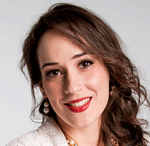 Joeanally Gonzalez was born and raised in Puerto Rico. For as long as she can remember, she had a passion for the world of design and the arts. While earning a Bachelor’s degree in Graphic Design from the School of Fine Arts in Puerto Rico, she also worked in the Puerto Rican film industry for over six years. In pursuit of her passion for the design industry, she relocated to Orlando, Florida, where she worked at Walt Disney World as a costume designer assistant. Joeanally Gonzalez was born and raised in Puerto Rico. For as long as she can remember, she had a passion for the world of design and the arts. While earning a Bachelor’s degree in Graphic Design from the School of Fine Arts in Puerto Rico, she also worked in the Puerto Rican film industry for over six years. In pursuit of her passion for the design industry, she relocated to Orlando, Florida, where she worked at Walt Disney World as a costume designer assistant.READ MORE After eight successful years with Walt Disney, Joeanally moved to Portland, Oregon in 2017. She became involved with the Bienestar de la Familia to empower women to use art as a way to heal and help them recognize their cultural and social needs. She also became an art teacher for an after-school program and a Paraeducator at North Clackamas School District. For her, art education can be very beneficial for children as they grow and learn. It can be an important part of a child’s development, helping them to develop their creativity, self-expression, fine motor skills, attention to detail, cultural appreciation, and confidence. Joeanally was born and raised in Puerto Rico. For as long as she can remember, she had a passion for the world of design and the arts. While earning a Bachelor’s degree in Graphic Design from the School of Fine Arts in Puerto Rico, she also worked in the Puerto Rican film industry for over six years. In pursuit of her passion for the design industry, she relocated to Orlando, Florida, where she worked at Walt Disney World as a costume designer assistant. After eight successful years with Walt Disney, Joeanally moved to Portland, Oregon in 2017. She became involved with the Bienestar de la Familia to empower women to use art as a way to heal and help them recognize their cultural and social needs. She also became an art teacher for an after-school program and a Paraeducator at North Clackamas School District. For her, art education can be very beneficial for children as they grow and learn. It can be an important part of a child’s development, helping them to develop their creativity, self-expression, fine motor skills, attention to detail, cultural appreciation, and confidence.
As an artist, I draw inspiration from the world of design and the arts, which have been a passion of mine since childhood. My education as a graphic designer, coupled with my experiences in the entertainment industry, has helped me hone my skills as a creative and detail-oriented artist. However, it was my experience as an art teacher that truly deepened my appreciation for the power of art to shape and transform lives. While teaching an after-school program and working as a Paraeducator at North Clackamas School District, I saw firsthand the positive impact that art education can have on children’s development. Watching my students grow and develop their creative skills was a source of immense joy and fulfillment for me as an artist and a teacher. As an artist, I seek to express myself and share my experiences with others. I believe that art has the power to communicate emotions and ideas that words cannot always capture. My goal as an artist is to create work that not only captures the viewer’s attention but also sparks an emotional connection with them and a learning experience. My dedication to using art as a tool for healing and education is also reflected in my work with Bienestar de la Familia. There, I worked to empower women to use art as a way to heal and help them recognize their cultural and social needs. Overall, my work as an artist is informed by my passion for design, my experience in the entertainment industry, and my dedication to using art as a tool for healing, education, and personal development. The proposed project has two parts. The first part , supported with the Milagro Artist Fund grant, aims to create bilingual copies of a published story called “Nico, la babosa de plátano,” for donation to the teachers of Milwaukie El Puente Bilingual School (grades K-5) in Clackamas county. The story which is originally in Spanish, centers around Nico, a banana slug, and his challenges in crossing a road in Forest Park, one of the largest urban forest reserves in Portland, OR. The story emphasizes the importance of preserving and protecting the environment by highlighting Forest Park’s unique fauna and flora. You can find this story as an ebook in the Multnomah County Library’s ebook collection. In addition to the bilingual book donation, the project’s second part involves a read-aloud tour through Milwaukie El Puente Bilingual School, The read-aloud will be followed by an art project related to the story, providing an engaging and interactive educational experience for children. The project aims to teach children about the environment and instill in them a sense of responsibility and appreciation for the environment. By introducing children to Forest Park’s unique fauna and flora through the story of Nico, the project hopes to inspire the next generation of environmental stewards. As part of my support for Portland Audubon, I am proposing an additional read-aloud event that will take place at Audubon facilities for a group of 15 children. After the read-aloud, I will lead an art project and a small tour into the Forest park woods to look for Nico and the characters and flora in the story. The Audubon manager is excited about this idea and is willing to make it happen. The project’s overall goal is to inspire a love for nature in children and create a lasting impact on their environmental consciousness. |
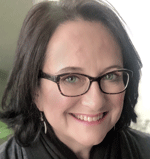 Julie Lopez is a Latina artist based in Portland, Oregon whose work spans from analog to digital photography, exploring themes of place, portraiture, and identity. With a deep connection to photography since childhood, Julie went on to earn a degree in photography from Brooks Institute of Photographic Arts and Sciences in Santa Barbara, California, launching a career as a professional photographer specializing in portraiture and documentary photography. Julie Lopez is a Latina artist based in Portland, Oregon whose work spans from analog to digital photography, exploring themes of place, portraiture, and identity. With a deep connection to photography since childhood, Julie went on to earn a degree in photography from Brooks Institute of Photographic Arts and Sciences in Santa Barbara, California, launching a career as a professional photographer specializing in portraiture and documentary photography.READ MORE Julie’s work has been recognized with local and national awards and has been published in national magazines, books, and literary journals, and featured on HGTV. Her photographs have been exhibited in solo and group shows both in the U.S. and internationally in Japan and England. Recently, Julie has embarked on a deeply personal project seeking to understand her relationship with her father, who struggled with mental illness. Using a mix of analog and digital techniques, she explores themes of memory, nostalgia, and the complexities of familial bonds.
Julie’s latest project, “Love, Bigfoot: Re-imagining Life and Conversations with My Father,” uses handwritten letters, portraits, and multimedia to explore the impact of mental health on a father-daughter relationship. Through the exploration of real and imagined conversations between a father and daughter, I hope to underscore the value of open, honest communication and the impact it can have on our emotional well-being. I also hope that the project will serve as a source of inspiration and hope for those who have experienced similar challenges in their own lives. Ultimately, “Love, Bigfoot” is a testament to the power of imagination to bring healing and understanding to strained relationships by re-imagining the lost conversations and missed opportunities of the past. “Love, Bigfoot: Re-imagining Life and Conversations with My Father” is a creative project that aims to explore the complex and emotional nature of a father-daughter relationship impacted by mental health issues. The project is inspired by my father’s habit of signing his cards and letters with “Love, Bigfoot”. Through a series of imagined conversations and re-imagined life events, this project will delve into the challenges and joys of growing up with a father whose mental health challenges often stood in the way of meaningful communication and understanding. Through a combination of written letters, photographs, and multimedia elements, this project will offer a window into the mind and heart of a daughter longing to connect with her father. Each letter will reflect on a specific moment or event from the past, re-imagined in a way that explores what might have been possible if the barriers to communication had been overcome. The accompanying photographs and multimedia elements will add a layer of visual and emotional depth to the project, creating a sensory experience that will immerse visitors in the complex emotions of the father-daughter relationship. At its core, “Love, Bigfoot” is a project about the power of imagination and communication to bridge the gaps that mental health issues can create in family relationships. By rei-magining the lost conversations and missed opportunities of the past, this project aims to bring healing and understanding to a father-daughter relationship that was often clouded by pain and misunderstanding. Ultimately, “Love, Bigfoot” is a testament to the enduring power of love and the transformative capacity of creativity in challenging circumstances. This project can benefit and service the community in several ways. First and foremost, it can help to raise awareness about the impact of mental health issues on family relationships. By sharing my personal story, I hope to reduce the stigma around mental illness and encourage more open and honest conversations about mental health within families. Secondly, the project can offer support and validation to others who may have had similar experiences with a loved one who has mental health issues. By sharing my own struggles and emotions, I hope to create a sense of community and understanding for those who may feel isolated or alone in their experiences. Additionally, the project can serve as a source of inspiration and hope for those who may be struggling to communicate with a loved one who has mental health issues. By showing the power of imagination and the value of communication, I hope to offer a new perspective and potentially even help to facilitate healing within family relationships. Overall, “Love, Bigfoot: Reimagining Life and Conversations with My Father” has the potential to benefit and service the community by raising awareness, offering support and validation, and inspiring hope and healing. It is my hope that this project will contribute to a more compassionate and empathetic understanding of mental health within families and ultimately help to strengthen and improve these important relationships. |
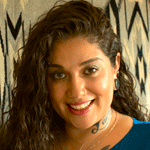 Kaylee Morgan Fernandez Kaylee Morgan FernandezMi familia y yo nos venimos de Chile cuando tenía 9 años en el 1998. Empece a enfocarme en ser artista profesional a los 16 años. Mientras estaba en la universidad empece mi carrera de intérprete médico/legal y saqué mi Licencia de Bellas Artes (BFA). E tenido la oportunidad de enseñar y ser tutora de las artes, crear comisiones, crear logos para diferentes negocios, y ser diseñadora de sitios de web. READ MORE My family and I came from Chile when I was 9 years old in 1998. I began to focus on being a professional artist at the age of 16. While in college I began my career as a medical/legal interpreter and earned my Bachelor of Fine Arts (BFA). I have had the opportunity to teach and tutor the arts, create commissions, create logos for different businesses, and be a website designer.
This animated series describes the steps of how to reach the goal of having true unconditional self-love. The process of how to let go of pain, grief, and turmoil in order to have inner liberation. This animated series describes the steps of how to reach the goal of having true unconditional self-love. The process of how to let go of pain, grief, and turmoil in order to have inner liberation. |
 Karma Rivera is a rising rapper hailing from Portland, Oregon. Born in Chicago and raised in a diverse and artistic community, Karma has always been drawn to music and the power of storytelling. She first began writing poetry as a way to process her emotions and experiences, but quickly discovered her talent for crafting intricate rhymes and thought-provoking lyrics. Karma’s talent has not gone unnoticed, and she has quickly made a name for herself in the Portland music scene. She has performed at a range of venues and festivals throughout the Pacific Northwest, Karma Rivera is a rising rapper hailing from Portland, Oregon. Born in Chicago and raised in a diverse and artistic community, Karma has always been drawn to music and the power of storytelling. She first began writing poetry as a way to process her emotions and experiences, but quickly discovered her talent for crafting intricate rhymes and thought-provoking lyrics. Karma’s talent has not gone unnoticed, and she has quickly made a name for herself in the Portland music scene. She has performed at a range of venues and festivals throughout the Pacific Northwest,READ MORE and has collaborated with a number of talented artists in the region. Through her music, Karma seeks to inspire and uplift others, encouraging listeners to find their own sense of empowerment and purpose.
As an artist, my mission is to use the power of music to inspire and empower others. I believe that music has the ability to create a sense of community and foster connection, and I am committed to using my platform to promote social change and encourage self-expression. My style is raw and unfiltered, and I am committed to staying true to my own creative vision, regardless of trends or popular opinion. I believe that authenticity is key to creating great music, and I strive to bring my most genuine self to every project. Ultimately, my goal as an artist is to create music that resonates with people on a deep and meaningful level. I hope to inspire listeners to take action, whether that means standing up for what they believe in, pursuing their passions, or simply embracing their own individuality. Through my music, I aim to uplift and empower others, while also creating a sense of connection and community that transcends boundaries and brings people together. This project involves creating a music video and developing a marketing plan to promote the video and the song. The goal of the project is to increase my visibility and reach, promote the song to a wider audience, and build a loyal fan base. Music Video: The music video will be visually appealing and tell a story that complements the song’s theme and lyrics. The video’s production quality will be high, and it will be shot and edited professionally. The video’s length will be around 2-3 minutes, and it will be suitable for broadcast on various digital platforms, including YouTube and social media. Marketing: Marketing is essential to the success of the music video and the song. The marketing plan should include both online and offline promotional activities. The goal of the marketing plan is to build buzz around the music video and the song and increase engagement with my fan base. |
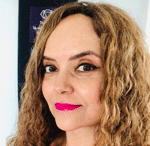 Maria Osterroth is from Mexico City, where she worked as a journalist at several publications including Reforma Newspaper, one of the biggest and most influential newspapers in Mexico (www.reforma. com.mx). At Reforma, one of her responsibilities was interviewing international businessmen, and writing special economic reports. She has a Bachelor’s Degree in communication science from Universidad del Valle de Mexico and also has studied economics and finance. Maria moved to Portland in 2005. She studied at Portland Community College in order to Maria Osterroth is from Mexico City, where she worked as a journalist at several publications including Reforma Newspaper, one of the biggest and most influential newspapers in Mexico (www.reforma. com.mx). At Reforma, one of her responsibilities was interviewing international businessmen, and writing special economic reports. She has a Bachelor’s Degree in communication science from Universidad del Valle de Mexico and also has studied economics and finance. Maria moved to Portland in 2005. She studied at Portland Community College in order toREAD MORE improve her skills in English. She concluded the ENNL Program (English as a Non-Native Language.) She also has taken journalism, writing and Public Speaking classes. In 2007, she founded the Portland Latin American Film Festival, a non-profit cultural organization dedicated to showcasing perspectives of Latin American culture through an annual exploration of Latin American films. In addition to the PDXLAFF, Maria has worked as a freelance interpreter for Hecht & Norman, LLP. She also has worked as a freelance reporter and translator for the bilingual newspapers, El Hispanic News, El Latino de Hoy and El Centinela Católico in Portland, Oregon
For the seventeenth consecutive season, the PDXLAFF will host at the Hollywood Theatre six or more screenings of new award-winning films that explore social and cultural issues of Latin America followed by panel discussions, music and networking events. The festival will start on September 27th in celebration of the Hispanic Heritage Month. This festival encourages dialogue among cultures, explores and celebrates the art of contemporary Latin American filmmakers. PDXLAFF mandate is the encouragement and appreciation of motion pictures as a medium of art, information and education. We have screened over 150 internationally awarded films, and hosted 20 artists (actors, directors and film professors from Latin America.) PDXLAFF conduct a Film Festival for the purpose of educating and advancing the public’s understanding and appreciation of Latin American cinema. We present films with universal appeal that can be enjoyed by native Spanish, Portuguese, English speakers, and other lovers of the Latin culture. We provide independent media artists with the opportunity to present and discuss their works with an engaged audience. We promote cross-cultural understanding and dialogue, and enrich Portland’s arts and cultural landscape. |
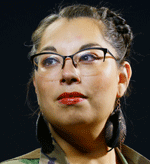 Mika Martinez Mika MartinezLiving as a guest on the Multnomah and Chinook first nation territories, Mika is a visual storyteller with more than twenty years of experience. She’s a changemaker who believes that healthier communities are made through collaborative expressions. Her desire to uplift and connect people using visual storytelling is why she works to support others in sharing their experiences and ideas. Mika is a self-taught artist who learned photography on the READ MORE job and until 2019 worked with cameras that were gifted to her by those who saw her passion and potential. She’s photographed everything from babies and families to edgy boudoir, weddings, and pivotal moments in history. As a Queer second-generation Mexican American, she’s passionate about using photography to transform ideas of possibility by sharing and creating stories that are bold and authentic. Her work includes a broad representation of people, touching on topics such as; body positivity, the experiences of Black, Indigenous, and People Of Color, the LGBTQIA+ community, and feminist narratives. By sharing authentic representations of people, her work is created to inspire a more inclusive world and to invite people to see themselves as valued and reflected in it. She’s changing the world one story at a time.
I’m most passionate about using photography to create a broader representation of people and ideas that are not commonly seen in visual media. Collaborative projects are a way for me to share authentic narratives that stem from my own experiences, perceptions, and observations of the world. I’m mindful of how people are presented and are conscious of the privilege I hold as a creator. It’s a humbling experience to be allowed to tell someone else’s story visually. Photography is my way of fostering positive change in the world, one snap at a time. My projects are an opportunity to further explore topics that directly affect the world around me while also providing the kind of representation and narrative that I would like to see more of in visual media. There’s a lot of power in imagery. The primary goal of my photography is to change perceptions. I’m always thinking about the impact the images will have on both the viewer and the person being photographed. My images spark change by inspiring and uplifting people. I believe there’s more that brings us together as people than what divides us. I want to embrace and celebrate our beautiful differences with authentic imagery. The phrase, my culture is not a costume can be connected with icons, images, and styles throughout Latinx culture. La Calavera Catrina is one of the most recognizable symbols of the Día de Los Muertos holiday – yet many don’t know where she originated from or the evolution of her meaning. The project, “The History and Evolution of La Catrina”, expands on the representation of Latinx people, while providing an understanding of Mexican history, traditions, and experiences; by sharing authentic cultural expressions around the figure, La Catrina. This well-known icon is an example of the power that art has as a reflection of society and how Mexican culture is a blend of indigenous traditions, colonial influence, and African customs. The project creates five different Catrin(a) looks to be photographed and exhibited during Portland’s 2023 Día De Los Muertos celebration. All of the collaborators involved from the models to the creators, identify as Mexican or Mexican American. They each provide a unique viewpoint, experience, and connection to the project. The different looks to broaden the scope of media around Latinx identity by prioritizing the voices of the Mexican LBGTQIA+ experiences and Afro and Indigenous individuals through collaboration. The images celebrate diverse bodies and highlight the experiences of those connected to Latinx identity who are less represented within mainstream media. Included with the photo exhibition, will be a printed booklet about the history and evolution of La Catrina and her meaning today. The created booklet is an educational resource that can be reproduced and shared on its own or alongside the images to provide a better understanding of Mexican culture and this celebrated icon. The second part of the project is a documentary film that further dives into the history and evolution of La Catrina, as well as Mexican culture and traditions. The film incorporates the entire project, from the origin of La Catrina and the creators who made her famous, to her evolution as one of the most recognizable symbols in Mexican culture. It expands the way Mexicans are seen by centering Black, Indigenous, and LGBTQIA+ voices through recorded interviews with the collaborators, while also providing insight into their personal connection to La Catrina and Día De Los Muertos. Documented during the creation of the photos and exhibition, the film consists of behind-the-scenes footage of the project, unpublished photos, reactions to the exhibition, and in-depth information about the history of La Catrina and this traditional Mexican holiday. Each part of the project expands on the history of one of Mexico’s most recognized and celebrated icons. The photos, the booklet, and the film are invitations for people to better understand La Catrina and the people and culture she comes from. Together, the project celebrates individual and cultural experiences by centering a broad range of Mexican voices. Expanding on the kind of representation that’s frequently presented around Latinx people, “The History and Evolution of La Catrina” creates an understanding of La Cultura for those interested in learning more. When people think about Latinx folks they might think of people who look along the lines of Jennifer Lopez, Marc Anthony, or Eva Mendez. Ignorance and the media have played a huge part in how this narrative was shaped. The project benefits the community by fostering a culture of inclusivity. Featuring diverse perspectives of Mexican and Mexican American people, specifically the experiences of Afro and Indigenous Mexicans. The project will contribute to a culture of inclusivity by expanding the kind of representation presented around Latinx folks, within the Portland community, and wherever it’s shared. These unique perspectives and experiences touch on intersectional aspects of identity such as gender, sexual orientation, body shape and size, and age. This visibility serves both the individuals who are part of the project as well as those who are experiencing the work for the first time. Being seen and included is no small thing, the project builds acceptance within the community, self, and culture by sharing authentic expressions around the figure La Catrina. It contributes to a stronger community by challenging the mold of what a Mexican should be or look like while breaking down barriers and creating a more inclusive perspective of La Cultura. It fosters a greater understanding and empathy through representation and inclusion. The project serves to build community by bringing together creators who are proud of their heritage and who want to share that with others. Visibility is one of several benefits the project provides. It also creates multiple educational opportunities for viewers to learn about Mexican history, traditions, and experiences. Each component of the project adds to a greater understanding of the origin, meaning, and evolution of La Calavera Catrina while also sharing the significance of Dia De Los Muertos. By presenting diverse perspectives and experiences in conjunction with historical facts, the project will serve as a resource to increase curiosity and provide people with an opportunity to learn about Mexicanidad culture. Simultaneously, it will expand people’s understanding connected to race and ethnicity. It will inform and educate about the history and diversity of Mexican culture and people while opening minds about the significance of this recognized symbol and why Catraina is not a costume. |
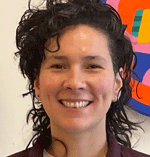 Paulina Levaggi Paulina LevaggiBorn in Salto, Uruguay. At the age of 18 I moved to Montevideo, the capital of Uruguay, and while working as a music teacher, I began a 5-year path at the School of Arts. I explored different techniques and languages of Art, later focusing on Graphic Design. I immigrated to the United States in 2017, first to New Jersey and in 2020 to Portland where I have lived ever since. I worked as a Graphic Designer always with a focus on illustration, & I READ MORE designed different abstract pieces and book covers published in Uruguay. Living in Portland I worked with the Portland Street Art Alliance (PSAA) and had the opportunity to paint my first solo mural located in the Goose Hollow neighborhood. I have participated in local markets, art shows, and other projects with PSAA. In July 2022 I started my apprenticeship as a tattoo artist, which I continue to develop every day. I am currently part of the “Into Her Eyes” art exhibit in observance of women’s history month in Old Town Portland.
I have been making Art since I was very young. As an introverted person I have always found a refuge in Art, a very intimate sacred-spiritual place where I can connect with the world that exists only in myself. Abstract Art is the channel through which I capture thoughts, worldviews, ideas, feelings and emotions that often do not have a defined figurative form or do not have a rational meaning, many other times they are paradoxical and there are small realities occurring at the same time in opposite directions. I seek to share and invite the viewer with their own inner world to find new ways and meanings, always keeping in mind that our history and experiences make us have different points of view. That is why I look for my work to have movement, rotating each piece 360 degrees and embracing a place for different perspectives. The project consists of the construction of 3 interconnected large wooden circular pieces forming a rotational larger piece that is the work itself. This project starts with 3 different digital designs that later will be drawn and painted on 3 circular wood pieces, each finished with resin. These 3 pieces will be interconnected on the back part with cogs and gears that will allow them to rotate at the same time. The 3 pieces will be able to rotate 360 degrees individually and because they are interconnected with the others, each rotation will affect the other 2 pieces. There will be a tab to encourage the viewer to rotate the pieces however they want. Each of the circular pieces will have vibrant abstract designs and the idea is for the rotation to alter the viewers’ perspectives of each individual circle as well as the overall larger piece depending on the point where they are viewed. With this work I seek to capture the idea of how, when we change our perspectives, the possibilities and reality around us also change, using each piece as an analogy of different realities. I believe that this project will serve the community as an object of reflection on the diverse and infinite perspectives that exist. The rotational and functional pieces take an active participation of each individual who is in front of the work. The project invites the viewer to explore abstract art and open the possibility to imagine new realities and perspectives through this experience. Interaction with the piece increases awareness of the changes and new formations, depending on the angle it is being viewed. In a world with an increasingly divisive society, I want to use my Art to bring unique individuals together and to participate in having a different experience while being in the same place at the same time. Just as I offer a unique voice and perspective, being a woman from a small country in South America, I believe every human has their own unique voices and perspectives too. Art is a powerful tool to generate conversation and to exchange ideas about making change and positive growth within a community. The concept behind this piece is to remind the person moving the pieces that individually, we have the power to make big changes, and that those changes affect others as well. I want to use this platform to raise awareness of this concept. |
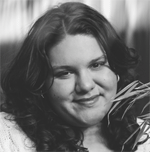 Sofia Carpenter-Rodriguez has been working at Bohio Studio for the past 5 years. Her main job at Bohio is making sure that events run smoothly, completing sales, editing grants, and photographing events. She is also a student at the University of Oregon, majoring in Sociology and minoring in Spanish. Recently she has been working with Bohio Studio for an average 15 hours a week, mostly doing tasks remotely. But still works very closely with them. Sofia Carpenter-Rodriguez has been working at Bohio Studio for the past 5 years. Her main job at Bohio is making sure that events run smoothly, completing sales, editing grants, and photographing events. She is also a student at the University of Oregon, majoring in Sociology and minoring in Spanish. Recently she has been working with Bohio Studio for an average 15 hours a week, mostly doing tasks remotely. But still works very closely with them.READ MORE My goal for any project I work on is to make sure that everyone feels included. I want to ensure everyone who I work with prioritizes diversity, inclusivity, and equity. I want to help people share their culture throughout our city, but also our state. – Central themes in my art are diversity and the fusion of different ideas and cultures. I show those themes using collage. Ultimately, I try to tap into universal concepts and feelings, things that are accessible across cultures. I think that diversity is the first step in creating any artistic or cultural movement. The next step is the fusion of ideas and cultures to create a whole that is greater than the sum of its parts. When groups are divided and maintain only their separate identities, they are unable to transcend and enrich the larger society. In my work and life as an artist, I try to reach beyond borders and languages to find a way of communicating that is at the same time playful and universal.
The game ‘Loteria’ is a version of bingo loved by many Hispanics all over the globe. It is played the same as bingo, four in a row in any way, or all four corners are a win. When you win you yell out “¡Loteria! “. We have shared this version of Lotería all around Oregon. This version of the game helps create a more inclusive game for families to share, helps share Hispanic culture, and helps people learn new languages. There are 52 different squares in both Spanish and English. We have also replaced less correct cards with more inclusive cards. I am currently a Sociology major at the University of Oregon and one thing we are always being asked to do is look at how we can learn as a society. We look at how we learn best, at times it is with multiple people, and through a visual method. For this project I am proposing a Lotería Oregoniana but Did De Los Muertos. We want to create a Lotería version that is a Dia De Los Muertos themed, making it a way for people to learn about Oregon, Dia De Los Muertos, but also making it a fun way to learn about it. We want to make it a way for people to learn about Hispanic culture, different aspects about it, and a way that people of all ages can learn about it. I want to make sure that people can learn about Hispanic culture and also learn more about the language. This is an incredibly effective way to do it. I would be working to Bohio Studio, the group behind the Lotería Oregoniana. We would like with use the Teatro Milagro building to share this project with the ideal audience. |
